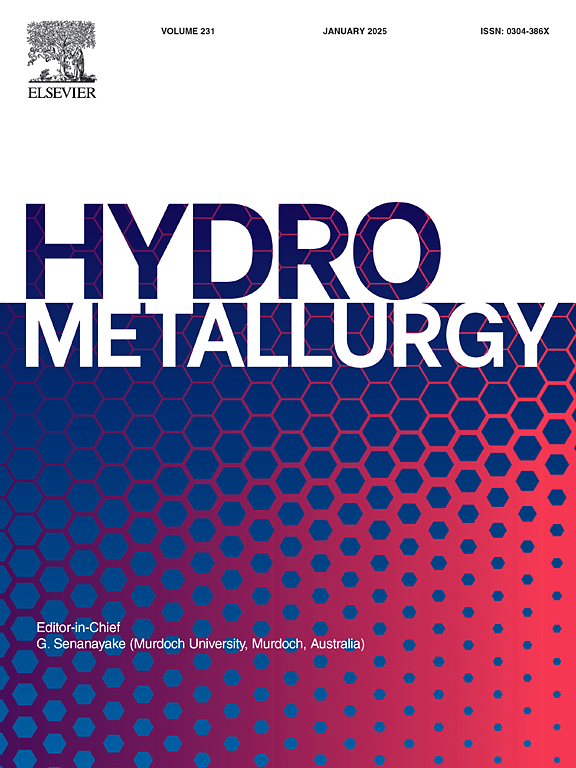在不同稀释剂中萃取稀土的亲脂性 EDTA 配体:在氯化物和硝酸盐介质中萃取钕(III)、镝(III)和镨(III)的初步结果
IF 4.8
2区 材料科学
Q1 METALLURGY & METALLURGICAL ENGINEERING
引用次数: 0
摘要
研究人员采用溶剂萃取技术,利用乙二胺四乙酸(EDTA)的一种新型亲脂性二酰胺衍生物,即 2,2'-N,N′-二癸基-二氧代-N,N′,N″,N″'-四氮杂四蒽-N″,N″'-二基二乙酸(H2E-4C10),研究了从氯化物和硝酸盐这两种不同介质中回收钕(III)的分离方法。初步筛选结果表明,二酰胺在 1,3-二异丙苯(DiPB)和 93:7 v:v 正十二烷:正辛醇混合物(DOm)作为非极性稀释剂中的溶解度(约 15 mM)是可以接受的。在 pH 值为 2 至 4 的氯化物和硝酸盐介质中进行了进一步研究,旨在确定与适合的萃取剂系统相关的操作参数。拟议系统的性能与 pH 值有关,在硝酸盐和氯化物介质中,pH = 3 时的负载能力达到峰值,分别为 1.7 和 2.0 g L-1。针对钕(Nd)和其他两种潜在竞争性镧系元素(即镝(Dy)和镨(Pr))的等摩尔混合物,测定了萃取效率、分配系数和分离因子(分别为 E%、D 和 SF)。在 pH = 4 的氯化物介质中观察到的最佳选择性为 SFNd/Pr = 1.48 和 SFNd/Dy = 2.03。在氯仿中,pH = 2 时钕与萃取剂的化学计量为 1:1 H2E:Nd。与所考虑的萃取平衡有关的热力学常数是通过 Van't Hoff 关系和斜率分析方法确定的。在选定的 pH 值范围内,Nd3+ 的转移机制受到稀释剂性质的强烈影响。用 H2E-4C10-Dom 体系(脂肪族稀释剂)萃取 Nd3+ 时,焓驱动转移;而用 H2E-4C10-DiPB 体系(芳香族稀释剂)萃取时,熵驱动转移。Nd3+ 的络合主要涉及酰胺官能团和羧基官能团的参与。阳离子向有机相的转移可能是通过形成 Nd(HE)A2 复合物(其中 A 是硝酸盐或氯化物阴离子)来实现的,无论水相进料如何,转移的相关标准吉布斯自由能都是最低的(-28 < ΔG° < -24 kJ mol-1)。本文章由计算机程序翻译,如有差异,请以英文原文为准。
Lipophilic EDTA-based ligands in different diluents for the extraction of rare earths: Preliminary results with Nd(III), Dy(III) and Pr(III) in chloride and nitrate media
A separation method for the recovery of neodymium(III) from two different media, chloride and nitrate, by implementing solvent extraction technique with a novel lipophilic diamide derivative of ethylenediamine tetraacetic acid (EDTA), namely 2,2’-N,N′-didecyl-dioxo-N,N′,N″,N″’-tetraazatetratriacontane-N″,N″’-diyl diacetic acid (H2E-4C10), has been investigated. Initial screening results demonstrated acceptable solubility (ca. 15 mM) of the diamide in 1,3-diisopropylbenzene (DiPB) and in a 93:7 v:v n-dodecane:n-octanol mixture (DOm) as non-polar diluents. Further investigations aiming at determining operational parameters associated with the befitted extractant systems were conducted at pH ranging from 2 to 4 in chloride and nitrate media. A pH-dependent performance of the proposed systems revealed loading capacity peaking at pH = 3 with the respective values of 1.7 and 2.0 g L−1 in nitrate and chloride media. The extraction efficiency, the distribution coefficients, and the separation factor (E%, D and SF, respectively) were determined for an equimolar mixture of neodymium (Nd) and two other potential competitive lanthanides, namely dysprosium (Dy) and praseodymium (Pr). The best selectivity was observed in the chloride medium at pH = 4 yielding SFNd/Pr = 1.48 and SFNd/Dy = 2.03. Neodymium-to-extractant stoichiometry was evidenced in chloroform to be 1:1 H2E:Nd at pH = 2. Thermodynamic constants related to the considered extraction equilibrium have been determined by using the Van't Hoff relation and the slope analysis method. It appeared within the selected pH-range that the mechanism of the Nd3+ transfer was strongly influenced by the nature of the diluent. This was illustrated by the enthalpy-driven transfer when Nd3+ was extracted with the H2E-4C10-Dom system (aliphatic diluent) while the transfer became entropy-driven when the extraction was performed with the H2E-4C10-DiPB system (aromatic diluent). The complexation of Nd3+ involved mainly the participation of both the amide and carboxylic functional groups. The transfer of the cation to the organic phase might occur through the formation of the Nd(HE)A2 complex (where A is either a nitrate or a chloride anion), allowing for the lowest associated standard Gibbs free energy of transfer (−28 < ΔG° < −24 kJ mol−1) regardless of the aqueous feed.
求助全文
通过发布文献求助,成功后即可免费获取论文全文。
去求助
来源期刊

Hydrometallurgy
工程技术-冶金工程
CiteScore
9.50
自引率
6.40%
发文量
144
审稿时长
3.4 months
期刊介绍:
Hydrometallurgy aims to compile studies on novel processes, process design, chemistry, modelling, control, economics and interfaces between unit operations, and to provide a forum for discussions on case histories and operational difficulties.
Topics covered include: leaching of metal values by chemical reagents or bacterial action at ambient or elevated pressures and temperatures; separation of solids from leach liquors; removal of impurities and recovery of metal values by precipitation, ion exchange, solvent extraction, gaseous reduction, cementation, electro-winning and electro-refining; pre-treatment of ores by roasting or chemical treatments such as halogenation or reduction; recycling of reagents and treatment of effluents.
 求助内容:
求助内容: 应助结果提醒方式:
应助结果提醒方式:


